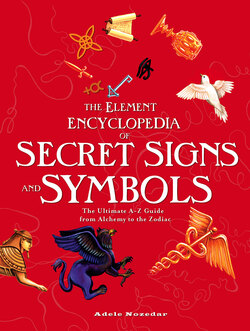Читать книгу The Element Encyclopedia of Secret Signs and Symbols - Adele Nozedar - Страница 148
RED
ОглавлениеSYMBOLIC MEANINGS: vitality and life-force; fire, the Sun, the South; blood; good luck and prosperity; power and authority; masculine energy; war and anger; passion, energy, sexuality.
One of the three primary colors, bright red pops out of whatever environment it happens to be in and grabs our attention more than any other color. Moreover, it is the first actual color that is seen by babies. Because it has a lower vibrational frequency than any other color in our visible spectrum, it is associated with the base chakra and symbolizes passion, sexuality, fertility, and animal urges. Red-light districts are so called because of the dim red shades of the prostitutes’ quarters.
Red is the color of blood, which means that it is associated with the life-forces and vitality. Hunters daub themselves in the red blood of the kill, which they believe will give them empathy with the spirit of the animal. Red is also the color of fire, the Sun, and the Southern direction.
The word for “magic,” in German, is directly linked to the word for “red ocher.” A recent archeological discovery provided unusual evidence of the reverence in which the color was held by early man. Lumps of red ocher, as well as tools stained with the substance, were found in early graves in an Israeli cave, indicating its importance as a symbol of vitality, life, and resurrection.
Pure colors used to be very difficult and expensive to produce, and so red cloth was used by people in positions of power, such as the monarchy and the clergy. Byzantine emperors were dressed from head to foot in red. In Rome, red was the color of nobles and generals, and the Holy Roman Church still dresses its cardinals in pure, bright, cardinal red. To roll out the red carpet for someone is to honor their presence.
Red is a color of protection and has been viewed as such for at least the last 2000 years. Amulets made from rubies or garnets were far more valuable than any other kind, able to make the wearer invincible.
And how about the red planet? Mars has a preponderance of iron oxide in its soil, giving it a red appearance that is clearly visible to the naked eye. This color is partially responsible for its association with war and warriors.
In India and China, red is the traditional color for weddings. Indian brides wear saris of red or pink, and the Chinese happy couple will be surrounded by a veritable sea of red; clothing, souvenirs, and gifts. Even the home of the bride and groom are decorated with red banners and ribbons. Roman brides, too, favored red for their wedding veil, which was called a flammeum. This tradition is shared by modern Greek brides.
In Ancient Egypt red was synonymous with evil, because it was the color of the God Seth, who haunted the arid desert places, the personification of destruction. Seth was called the “Red God,” and an Egyptian charm of the time goes like this;
Oh, Isis, deliver me from the hands of bad, evil, red things!
Similarly, in Christian symbolism, the Devil is sometimes depicted as a red creature. Like Seth, he also has a predilection for scorched places.
In alchemy, the Red Stone is mercuric sulfide, a compound of sulfur and mercury that is also called vermilion. The creation of vermilion was a very important primary stage in the process of making the Philosopher’s Stone, which is itself disguised as the Red Lion, since this elusive substance was characterized by turning red in its final stage.
